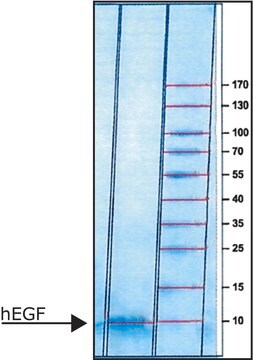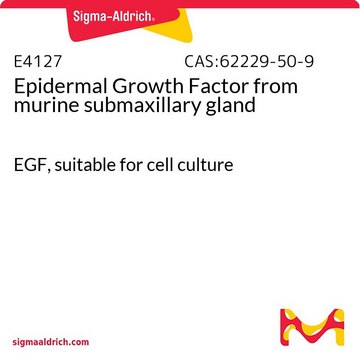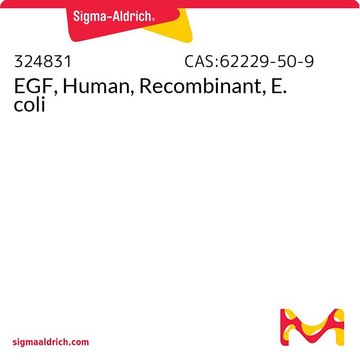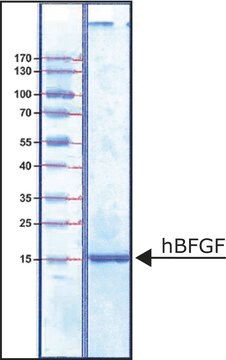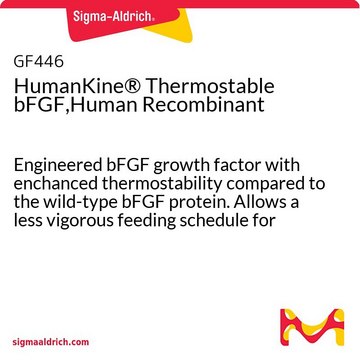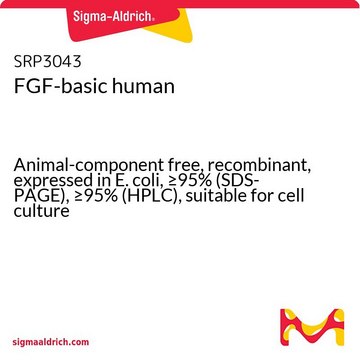SRP3027
EGF human
Animal-component free, recombinant, expressed in E. coli, ≥98% (SDS-PAGE), ≥98% (HPLC), suitable for cell culture
Synonym(s):
Epidermal Growth Factor, URG, Urogastrone
Sign Into View Organizational & Contract Pricing
All Photos(1)
About This Item
UNSPSC Code:
12352202
NACRES:
NA.32
Recommended Products
biological source
human
recombinant
expressed in E. coli
Assay
≥98% (HPLC)
≥98% (SDS-PAGE)
form
lyophilized
potency
≤0.2 ng/mL
mol wt
6.2 kDa
packaging
pkg of 500 μg
technique(s)
cell culture | mammalian: suitable
impurities
<0.1 EU/μg endotoxin, tested
color
white to off-white
UniProt accession no.
shipped in
wet ice
storage temp.
−20°C
Gene Information
human ... EGF(1950)
General description
The gene EGF (epidermal growth factor) is mapped to human chromosome 4q25-27. The EGF gene encodes for a large type I membrane–anchored precursor protein which is cleaved into pro-EGF for generation of peptide hormone EGF. The mRNA is expressed in kidney, salivary gland, cerebrum and prostate. Recombinant human EGF is a 6.2kDa globular protein containing 53 amino acid residues including 3 intramolecular disulfide-bonds.
Application
EGF (epidermal growth factor) human has been used in the culture medium for the maintenance of MCF10A cells (human mammary epithelial cells).
Biochem/physiol Actions
EGF (epidermal growth factor) is a potent growth factor that stimulates the proliferation of various epidermal and epithelial cells. Additionally, EGF has been shown to inhibit gastric secretion, and to be involved in wound healing. EGF signals through a receptor known as c-erbB, which is a class I tyrosine kinase receptor. This receptor also binds with TGF (transforming growth factor)-α and VGF (vaccinia virus growth factor). Mutation in the EGF gene might be associated with risk of non- small cell lung adenocarcinoma. It is also involved in anaplastic thyroid cancer and renal hypomagnesemia. It controls cell differentiation and neurotrophic processes.
Sequence
NSDSECPLSH DGYCLHDGVC MYIEALDKYA CNCVVGYIGE RCQYRDLKWW ELR
Physical form
Lyophilized with no additives.
Reconstitution
Centrifuge the vial prior to opening. Reconstitute in water to a concentration of 0.1-1.0 mg/ml. Do not vortex. This solution can be stored at 2-8°C for up to 1 week. For extended storage, it is recommended to further dilute in a buffer containing a stabilizer (example 5% Trehalose) and store in working aliquots at -20°C to -80°C.
Storage Class Code
11 - Combustible Solids
WGK
WGK 3
Flash Point(F)
Not applicable
Flash Point(C)
Not applicable
Choose from one of the most recent versions:
Already Own This Product?
Find documentation for the products that you have recently purchased in the Document Library.
Customers Also Viewed
Basal p21 controls population heterogeneity in cycling and quiescent cell cycle states.
Overton KW
Proceedings of the National Academy of Sciences of the USA, 111, E4386-E4393 (2014)
Clinical Implication of EGF A61G Polymorphism in the Risk of Non Small Cell Lung Adenocarcinoma Patients: A Case Control Study.
Masroor M
Asian Pacific Journal of Cancer Prevention, 16, 7529-7534 (2015)
The miR-200 family regulates the epithelial-mesenchymal transition induced by EGF/EGFR in anaplastic thyroid cancer cells.
Zhang Z
International Journal of Molecular Medicine, 30, 856-862 (2012)
Neurotrophic actions of a novel molluscan epidermal growth factor.
Hermann PM
The Journal of Neuroscience, 20, 6355-6364 (2000)
Epidermal growth factor therapy and wound healing--past, present and future perspectives.
Hardwicke J
The Surgeon : Journal of the Royal Colleges of Surgeons of Edinburgh and Ireland, 6, 172-177 (2008)
Our team of scientists has experience in all areas of research including Life Science, Material Science, Chemical Synthesis, Chromatography, Analytical and many others.
Contact Technical Service